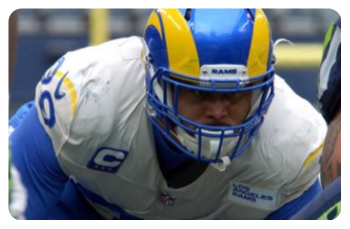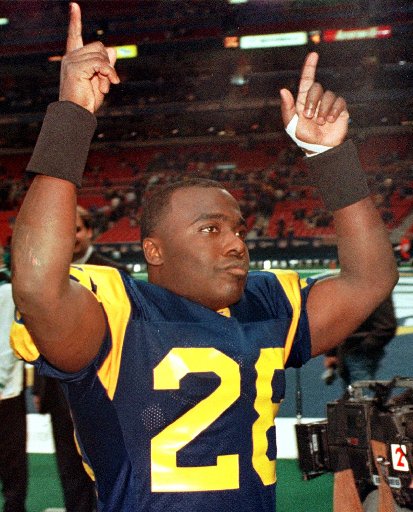http://www.stltoday.com/sports/foot...cle_29d281fd-4f62-5190-8148-e1fb2b5bca75.html
The seed was planted in Hawaii of all places, 12 years ago this week. John Shaw didn't attend many Pro Bowls, but for some reason the Rams' president was there following the 1998 season.
"I ran into Eric Dickerson, and Eric told me that they might want to trade Marshall Faulk," Shaw recalled. "Eric and Marshall were friends."
Dickerson, of course, is the Hall of Fame running back who started his career with the Rams before being traded to Indianapolis. Faulk, who could become a Hall of Fame back this Saturday when the selection committee meets in Dallas, started his career with Indy before being traded to the Rams.
Dickerson's "tip" may have piqued Shaw's interest; then again ...
"You hear a lot of rumors," Shaw said in a recent interview. "You never know. I never thought anything would materialize. It was just one of those things that you heard. It wasn't until a couple of months later that I really started talking to Bill Polian."
The Rams certainly needed the help in the backfield. During a dreadful 4-12 season, the team's rushing leader was June Henley. With a measly 313 yards.
The '98 Rams had a playoff-caliber group on the other side of the ball, finishing 10th in the league in total defense with a solid nucleus that included Kevin Carter, D'Marco Farr, Michael Jones, Todd Lyght and Keith Lyle. But on offense, they could barely avoid tripping over their own feet. In what was then a 30-team league, they finished 24th in scoring, 27th in total offense and 29th in rushing offense.
Late in the '98 season, in an otherwise empty locker room at Rams Park, Carter and Farr desperately pleaded for playmakers on offense if the team was going to end its string of nine straight losing seasons. The infusion of offensive talent from the '96 draft had turned out to be a disaster.
Troubled running back Lawrence Phillips already was gone. Quarterback Tony Banks and wide receiver Eddie Kennison were headed out the door. With just nine victories in his first 32 games, coach Dick Vermeil was squarely on the hot seat. The honeymoon was over among Rams fans, too, as the no-show count climbed into the thousands each home game.
Even the players weren't buying in. There was a near revolt at the start of the '98 season over Vermeil's grueling three-hour practices. At the end of the season, several players skipped the flight home from the finale in San Francisco in a clear sign of disrespect.
So there was a lot of pressure on the front office to make things right. What followed was one of the most dramatic makeovers in NFL history.
"It was unbelievable," Shaw said. "It all just kind of came together."
Free agency started in February in those days, and the Rams made two quick moves, signing Washington quarterback Trent Green and Green Bay offensive guard Adam Timmerman. At the NFL scouting combine, the team traded Kennison to New Orleans for a second-round draft pick.
"And we brought Mike (Martz) in that year as offensive coordinator," Shaw said. "That was a key piece. But while you're doing it, you still don't think that you can make a big enough move."
And what about running back? Were the Colts really trading Faulk?
The No. 2 overall draft pick in '94, Faulk already was established as one of the league's top running backs. In his first five seasons, Faulk topped 1,000 yards rushing four times and made three Pro Bowls. His '98 season was his best to date, with 1,319 yards rushing and 908 yards receiving.
Even so, he had an image as a malcontent, had knee issues and wanted a new contract that would pay him at a level commensurate with an elite back. In March, Dickerson's words to Shaw in Hawaii went beyond the stage of insider's gossip.
"The first I heard of it was when we were at the NFL owners' meetings in March," Vermeil recalled. "John Shaw said that Marshall Faulk was going to be available for a trade. Should we be interested? I said, 'You bet we should be interested.' So all of us went to work on it, and just continually shared our responsibilities in communicating with the powers to be in Indianapolis."
Shaw continued his discussions with Polian, the Colts' president. Vermeil worked on Colts head coach Jim Mora, whom he had known for a third of a century.
"And it would be on again, off again, on again, off again," Vermeil said.
"They were looking for a 'one' when we first talked," Shaw said. "And we had a very high one."
For the fifth season in a row, the Rams began an offseason with the No. 6 overall pick.
"There's no way we were going to give up the No. 6," Shaw said. "My recollection is then they wanted both twos."
The Rams had their original pick in the second round, No. 36 overall, plus the No. 41 overall pick they had acquired from the Saints for Kennison.
"But the team needed to build," Shaw said, meaning the Rams were unwilling to part with both second-rounders. "As things developed the conversation became a two, plus something."
That in itself was astonishing to Shaw, given Faulk's body of work. At the time, the Rams' personnel department had only Detroit's Barry Sanders and Denver's Terrell Davis, fresh off a 2,000-yard rushing season and second straight Super Bowl title, rated ahead of Faulk in the NFL.
"Now, not in a million years, when you hear that Marshall's going to be traded do you think that you could do it for a two," Shaw said.
Of course, while the Colts were talking to the Rams, they were also talking to other clubs, so things moved slowly. Good fortune as much as anything helped the Rams get Faulk for a bargain. Two of the teams most interested that offseason — Miami and New England — played in the AFC East along with Indy at the time. (Realignment wouldn't send the Colts to the AFC South until 2002.)
The Colts probably could have gotten more from the Dolphins or Patriots for Faulk, but Faulk agent Rocky Arceneaux and Rams vice president of player personnel Charley Armey, among others, said Polian was unwilling to trade Faulk to a division rival.
And there were two marquee backs in the draft that year in Ricky Williams and Edgerrin James. Their potential availability may have lowered what teams were willing to offer for Faulk, and may have even made the Colts — who picked fourth overall that year — willing to take less.
"It's kind of like the stars lined up for us," Shaw said.
But with just a few days remaining before the draft, there was still no deal.
"I remember being in Charley Armey's office with Charley, myself, Jay Zygmunt and John Shaw talking about it," Vermeil said. "And we were just sort of at a standstill. A stalemate. And I said, 'Wait a minute guys, I'm going to go call Jim Mora.'"
Vermeil went back to his office and called Mora, who was much more than a potential trading partner — he was a longtime friend. They were on John Ralston's Stanford staff in 1967, and when Vermeil became head coach at UCLA in 1974, Mora was his linebackers coach. The two old friends cut through the posturing and gamesmanship.
• Vermeil: "Jim, can we get this done?"
• Mora: "Yeah, I think we can. What are you offering?"
• Vermeil: "A second and fourth."
• Mora: "Let me find out."
Vermeil stayed on the line, while Mora went to get his answer.
"Jim comes back on the line and he says, 'It's a deal,' " Vermeil recalled.
Vermeil then walked back to Armey's office and said, "Guys, we just traded for Marshall Faulk. All the work you guys have put in, hey, it paid off.
"And John Shaw said, 'What did you give up?'
"And I said, 'A second and fourth.'
"And he said, 'That's too much. Let me talk to 'em.'
"John Shaw moved it from a second and fourth to a second and fifth. And then we all sort of high-fived and we knew we were getting a running back."
Martz, the new offensive coordinator, thought it was a prank when he found out about the deal.
"I didn't believe it," Martz said in a phone interview Saturday. "I thought they were teasing me. I wasn't involved in any of that. I just went in my office every day and closed the door, put my head down and went to work."
They weren't teasing. On Thursday, April 15, just two days before the '99 draft, the Rams announced the trade. Armey still can't believe how cheaply Faulk had come.
"A Hall of Fame player for a second-rounder and fifth-rounder?" he said earlier this month. "You'd give your mother up for that kind of a trade. He was the missing link for our team. We didn't have a running back at that point."
The Rams ended up using that No. 6 overall pick for wide receiver Torry Holt, putting the finishing touch on what would become one of the most explosive offenses in NFL history. Mike Ditka and the New Orleans Saints traded their entire remaining '98 draft to move up to the No. 5 spot for Williams, who had declined to meet with the Rams at the combine.
And at No. 4, the Colts ended up taking James, who had a lot of success in Indianapolis.
"But I tell you what, Edgerrin James is no Marshall Faulk," Armey said. "That might be one of the best trades in the history of the National Football League for value. I can't remember many trades as valuable as that one, for what you gave up and what you got."
Still, the trade wasn't immediately viewed that way by some.
"The market for Faulk wasn't great," ESPN's Chris Mortensen reported at the time. "I've talked to a lot of teams that didn't have strong feelings for Faulk. They felt the same thing as the Colts, that he only had one year you could maybe get excited about, and you don't give that kind of money to a running back who has two or three shelf-life years left, especially if you have doubts about his potential."
Alarm bells were even sounded in St. Louis after Faulk let it be known at his inaugural Rams news conference that he wouldn't report to minicamps or offseason work in St. Louis without a new contract.
Rams May Live to Regret Trade for Faulk read one headline in the Post-Dispatch.
But less than a year later, with the Lombardi Trophy sitting at Rams Park and the brief but spectacular Greatest Show on Turf era under way, it became known as the best St. Louis sports trade since Ernie Broglio for Lou Brock.







